

Hi Been to see my Japanese contact and acquired a few goodies. Better still we stood in the cold for an hour discussing how utterly boring the computer world has become. Microsoft are to blame.. and sadly all the sheep that followed into the valley of the suits.... Thinks ' Desktop Dynamite '... Now that's what I call fun.... Happy days. Anyway what I got...Nintendo Famicom Disk System
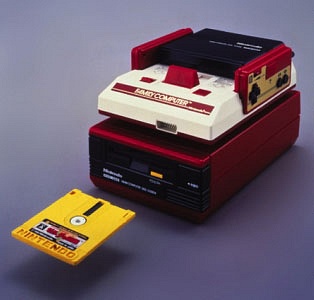
[ quote ] The Famicom Disk System was released in on February 21, 1986, by Nintendo Co., Ltd. and Mitsumi Electronics Co., Ltd. Though 212 Disk System games were officially licensed by Nintendo over the years, some argue the Disk System isn't really its own console but instead a Famicom accessory. You have to plug the Disk System into the Famicom to get it to work. The Disk System is two parts: the RAM and the disk drive. The Disk System connects to the Famicom via the RAM adaptor. It can be powered with C batteries or a power adaptor. Disks (officially called "disk cards") were inserted in front, like the standard '80s floppy drive, and were removed using a yellow eject button. Nintendo created the Disk System for various reasons, in part because Famicom gamers were begging for a way to save their progress in games. But Nintendo also wanted to increase the size of games. Cartridges had failed to provide the luxuries disks could provide. [ end quote ]Sega 32X
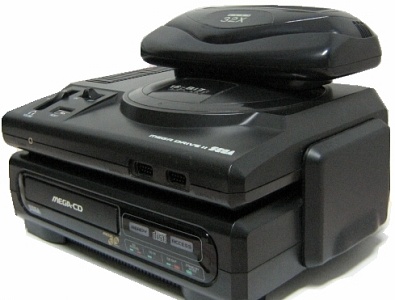
[ quote ] When the 32X was released in November 1994, the demand was so high that Sega couldn't fulfil all of the one million orders retailers had made for the system. By January 1995, Sega had shipped 600,000 units. The 32X plugged into the cartridge port of the Genesis console. Two 32-bit RISC processors powered the system. A VDP (video digital processor) chip noticeably improved the Genesis' polygonal graphics. It featured a palette of over 32,000 colors as well as texture-mapping. Owners of the Sega CD system could plug into the 32X to play enhanced CD-ROM games. [ end quote ]NEC Turbografx Console
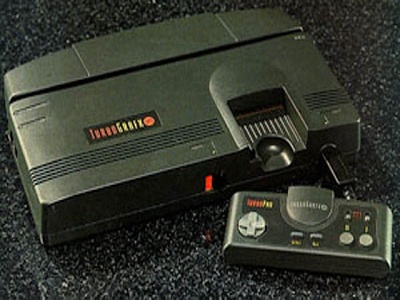
TurboGrafx-16 Specifications Central Processing Unit: Hu6280 [8 bit / 16 bit graphics processor] Clock Speed: 3.6 MHz Random Access Memory: 8k Maximum Available Colors: 512 Simultaneous On-Screen Colors: 482 Maximum Display Resolution: 320 x 256 Audio Processing Unit: PCM [6 Channel Stereo] [ quote ] NEC's TurboGrafx-16 suffered from a case of extreme bad timing and marketing. Released in 1989, just before the Sega Genesis, the Turbo was too little, to late. The Turbo had two things going against it. First, NEC was new to the gaming industry, going up against arcade veteran Sega, who was releasing their second home console. Second, the Turbo's hardware was inferior to that of the Genesis. Although NEC touted the Turbo as being a 16-bit system, the CPU was actually an 8-bit processor. The only 16-bit chip was the graphics processor, which actually was capable of displaying more on-screen colors than a Genesis. But as demonstrated with the SMS, it takes more than hardware to make or break a system. [ end quote ]Other goodies acquired
Two other goodies I got from the guy were... A Nintendo Super Famicom mint boxed [ This Famicom is in an all Japanese box ] and a Wonderswan mint boxed. This guy imports near unused Japanese consoles and the condition is just unbelievable. Good start to the week that. scuzz
Hi The Texas arrived today, and becomes even a bigger mystery. I will have to photograph the back and let you advise as to what these connectors are for. I can`t accurately date this unit. Its in fantastic condition and still has the original paper roll inside. The keyboard is a dream and would put any laptop to shame. More on this later.Personal Terminal 707 Moore
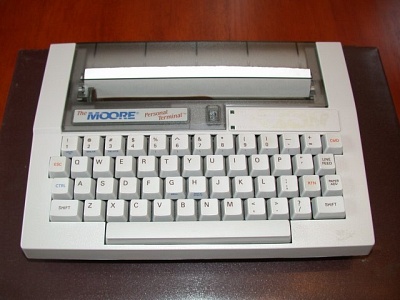
I had previously thought this to be a the ' Silent ' model. Turns out to be the Personal Terminal 707 named Moore. [ quote ] Thermal printer, direct connect modem. This terminal was made by Texas Instruments, marked on the underside as "Personal Terminal, 707, Moore". There are no physical switches as in earlier 707 models, but instead the settings are made by configuration commands. I don't know yet, whether this is a 300 or 1200 baud unit, but it appears to work. It comes with its own briefcase. [ end quote ] Not considered the concept of Terminals before. Opens the door on a whole new world of retro by the looks of it. scuzz
Hi I can mention this now... Retro Gamer did a wonderful spread this month on the humble Sinclair 128 the one with the ' heatsink ' on the side. ' The market wanted more memory and better sound in order to help produce more engaging games and that was done in the most mechanical way possible ' Rupert Goodwins Sinclair Research ' The ZX80, Zx81 and ZX Spectrum followed in quick succession but Sinclair bumbled and stumbled when it came to extending the ZX line, eventually releasing the Spectrum 128 in 1985 amid fears that the company was facing financial ruin 'Spectrum 128
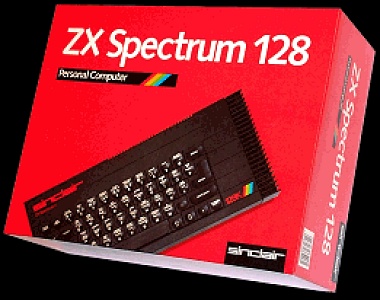
The Sinclair Spectrum 128 at the Computer Museum
At the launch of the Spectrum 128 Sinclair was struggling because of the failure of the QL. Clive Sinclair always viewed the games computer as ' beneath the dignity of the company '. Interestingly it was the success of the Spectrum in Spain that convinced Sinclair and investors to create a new games based machine..... ' Take a standard sound chip, gate in some more RAM., futz around with the system software and get it out as soon as possible. The result of all this was the Spectrum 128...' Whilst the 128 was a quick and dirty upgrade it did resolve many of the Spectrum's shortcomings '. ... One of the most noticeable differences was the replacement of the beeper with the three-channel AY-3-8912 chip. In addition to the 128K memory also came 128 BASIC and the dumping of the one touch key entry system. The issue of old software was to include the old 48K ROM on the machine so you could switch between 128 and 48. One cool aspect of the 128 is the whacking great heat sink down the one side of the machine. Because the 128 had more components that generated heat the unit got very hot. Interestingly the main source of heat was the voltage regulator. The sink was simply bolted to the side of the unit. There are great early production sketches of the sink by Rick Dickinson in Retro Gamer. I kinda kept quiet about this wonderful feature as I successfully tracked and won a number of the machines this last week. I have a boxed version here in its bold red box. As is traditional here I wont open the box till I photograph it... but as I wanted to play I got hold of a few units. I have learned my lesson with Speccy stuff... you get a one in three chance of them working. All cost around a tenner each so not a big investment. I guess having read this article I realised the significance of this machine. Classic really. [ that link again ] scuzz
Hi Probably the largest ever parcel to arrive here turned up today, and to my surprise inside was the very large Cifer computer. Somewhat surprised to be honest as I thought it was the MegaPC and monitor. I had thought that this beast was say as big as the Osbourne, but no quite a touch bigger... There is hardly anything about this computer on the internet other than an entry about its sister computer without the 5.25" drive... SeeCifer 2683
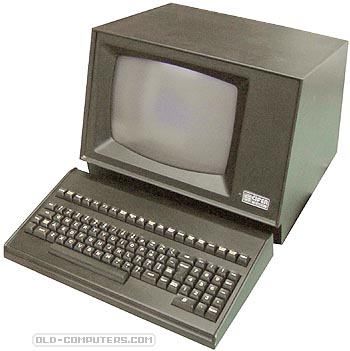
This is the smaller version of the one I have
Click to access the Old Computer Museum
[ quote ] The Cifer 2683 was the stand-alone version of a large range of dumb terminals released in the UK by the Cifer Systems Limited Company. The 2683 was actually a Z80 based 2632 terminal to which a second Z80 card has been added, providing 64 KB of user RAM and a floppy-disk controller. The machine was used as a Z80 software development or general purpose CP/M system. A ROM/EPROM card allowed to develop and run custom programs. A 300 x 1024 pixel graphics board was also available, including a third Z80A CPU and providing Tektronix 4010 compatibility. A 2684 was also released, with same features as the 2683 but including a built-in 5.25" floppy-disk drives instead of an external unit. [ mine is obviously the 2864 ] NAME 2683 MANUFACTURER Cifer Systems TYPE Professional Computer ORIGIN United Kingdom YEAR 1982 BUILT IN LANGUAGE None KEYBOARD 100 key Typewriter type with 20 function key and numeric keypad CPU 2 x Z80A SPEED 2.5 MHz RAM 64 to 256 KB VRAM 16 to 32 KB ROM Depends on system configuration, up to 24 KB TEXT MODES 80 characters x 25 lines - 8x12 dot char. format GRAPHIC MODES 300 x 1024 (optional) COLORS Monochrome. White green or orange phosphor SOUND No sound SIZE / WEIGHT 41 (W) x 35 (D) x 34 (H) I/O PORTS Parallel printer (2), serial lines (2), FDD unit, Composite video BUILT IN MEDIA Dual DS DD 48 TPI floppy-disk unit OS CP/M 2.2 POWER SUPPLY Built-in power supply unit PRICE Unknown [ Thanks to Old Computers Com Museum ] Comments from seller.... My memory isn't that good, it was last powered up 11 years ago, I can't even remember if the screen is orange, green or white / black. It didn't come with notes. I wasn't planning on cleaning it, if I had the time to clean it and get it going again it would have sold for more, I'm surprised it sold for as much as it did considering its condition. I'm just clearing a storeroom, the dust is mainly plaster , as the building had some major work done on it. The keyboard metal plate is bent because the keyboard had several cardboard boxes stacked on top. finding the missing piece is doubtful, I would have expected it to be next to the computer which it wasn't, hence it must have been moved around. either something fell on it or someone dropped it. Thinking it might power up after all this time was a bit optimistic, I should have used a dummy load in series and raised the voltage slowly, however I don't have any affectionate connection with this red box, so I thought just plug it in. It popped the fuses a couple of times, and took the cover off to see the psu. I cut an earth wire which needs re connecting, other than that the power supply isn't a complex one , with more TL care you are in with a chance. In fact thinking about it, it would probably be a good idea to unpower the internal monitor, connect external monitor to the video socket on rear and then try powering up. after you have verified what's coming out of the power supply. Cifer Club It has 11 years of dust on it, and the faded stickers say working 1997, I remember it working 11 years ago, I put the stickers on, 11 years ago when I powered it up, it hadn't been used for a long time, it ran something like CP/M or Unix, I think it dates to around 1980. It is made in UK. it has a very large hard drive inside, this is only physically large its actual capacity is most likely 10MB. It used to boot from the hard drive, Interesting... Needs a good clean up before I photograph this. scuzz
Hi Three Sinclair ROM cartridges arrived today. These are quite rare.. Jet Pac, Hungry Horace and Cookie.. [ quote ] John Gilbert wrote in Sinclair User in 1984, ' The ROM cartridge market was very immature and unestablished and making an order of this quantity a risky business, even for a company as established as Melbourne House or Psion. Unsurprisingly, none of the ten original releases sold well in the cartridge format and despite much talk of further software, it never materialised. Within a year of its release, the Interface Two, along with the cartridges, had been consigned to the dustbin of computing history. 'Typical Sinclair ROM Cartridges
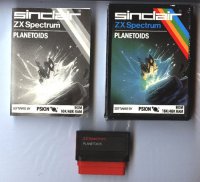
[ end quote ] Other ROM cartridges in the series were - Planetoids (Sinclair Research Ltd) - Space Raiders (Sinclair Research Ltd) - Backgammon (Sinclair Research Ltd) - Pssst (Ultimate Play The Game) - Cookie (Ultimate Play The Game) - Jetpac (Ultimate Play The Game) - Tranz Am (Ultimate Play The Game) - Hungry Horace (Sinclair Research Ltd) - Horace and the Spiders (Sinclair Research Ltd) - Chess (Sinclair Research Ltd)Click to access the Sinclair Lair
Quite sexy all the same. scuzz
Hi I guess no computer retro enthusiast would be without a few classic games. Asteroids fits that bracket very well, particularly when coupled with an Atari console, or better still an arcade games machine. Dunno just how much money I spent on playing this in pubs and clubs when I was younger, but suffice to say it was pretty addictive in its day. Given that I have bought a few 2600s [ boxed one arrived today ] I thought I would treat myself to a few of the classics. [ quote ] The Creation of Asteroids Asteroids was inspired by Lyle Rains, who suggested to Ed Logg that players might enjoy shooting big rocks into smaller pieces. "I guess the way I describe it is that I'm the father of Asteroids," Rains said. "Ed Logg is the mother of Asteroids, because he had to live with it for nine months and deliver finished product. All I had to do was to provide a seed." Asteroids sits right up there with Pac-Man and Space Invaders as a classic. From the hypnotic bass to the swarming asteroid field this game had every intention of success. The production run for this game exceeded 70,000!! units. Asteroids was so popular that the production line for Lunar Lander was switched over to producing Asteroids games, this is why some Asteroids are in Lunar Lander cabinets (about 200 were done this way!). Your mission is basically to reduce the floating asteroids down to rubble and finally dust. Each asteroid when shot breaks into two smaller ones. As you create your destruction you must avoid enemy flying saucers that will try and shoot you down. The saucers come in two flavours, large and small. The large ones of course easier to hit and are much less accurate with their lasers, while the smaller saucers are quick and accurate(they also score 1000 points, motivation for saucer hunting). When you clear the level, alas... more asteroids appear, and in greater numbers.LINKS
Click to access klov.com and their Asteroid section
Click to access ozyr.com for their Asteroid section
Below you can watch Asteroids on YouTube
R E M O V E D
As I said earlier I had a boxed 2600 arrive today the large rainbow junior... and with it came 5 cartridges...Crystal Castles, Pheonix, Centipede, Mario Bros and Space Invaders. Great fun scuzz
The Apricot Portable arrived and as ever I struggled to see how anyone would lug this around. Not only quite heavy but a very off shaped brief case, which I have banged my knee on several times during the week.. Came with the software disk which was a plus.. though deficient of the mouse trackball and any manuals. A good find all the same....Apricot Portable
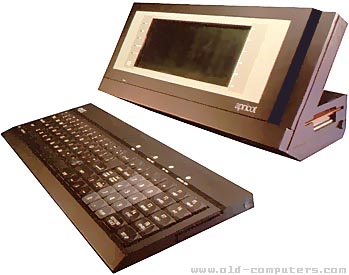
An article published in Personal Computer World in November 1984 explained how the voice recognition system works : "The voice system on the Portable allows you to have a vocabulary file of up to 4096 words. However, only 64 words can be held in RAM at any one time, so a fair amount of shuffling is necessary with large vocabularies. Before the system can understand your commands, it is necessary to create a vocabulary file and train the system to understand your voice. The Portable is supplied with a program which allows this to be done. The first thing to do is to create a vocabulary disk file. You can have as many of these as you like. The training program prompts for a name and then opens a diskfile under that name with a .VOC extension. Next you enter the words you want to use, along with an optional command which you want the machine to respond to. Once you have entered all the words, you can go into training mode. To do this you speak the words into the microphone and the program records the voice patterns. The more times you repeat each word the better the result. After you have trained all the words you can go on to see how well the machine understands you." The keyboard had no leads - it communicates with the main unit through infrared signals. But if you put an object in between the keyboard and the main unit, communication stops ! It was the same membrane keyboard as used with the Apricot F1. There was also an optional and quite innovative trackball available, but a classic Microsoft mouse could also be used through the serial port. The Apricot Portable shipped with the 'Activity' front-end to the operating system, an enhanced version of the one delivered with the Apricot F1. It was quite "Mac" influenced with icon-based navigation and even a built-in icon editor ! The Apricot Portable was supplied with a great deal of bundled software : SuperWriter, SuperCalc, SuperPlanner, ACT Diary, ACT Sketch and an interactive tutorial. The built-in disk-drive located at the right-hand side of the main unit was a Sony 3.5'' disk-drive, single-sided, 720k. ACT also supplied a little external 10 MB Rodime 3.5'' hard disk called an MSD (Mass Storage Device). The large LCD was the first full 25-line liquid crystal screen to be mounted on a portable computer. It was made in Japan by Hitachi, but ACT wasn't happy with the controller, so it designed its own (very fast) display controller chip. It's possible to adjust the contrast by holding down the CTRL and UP-ARROW or DOWN-ARROW keys together, but the angle of the display is fixed and cannot be tilted. But the Apricot Portable can also be connected to an external monitor and with the colour option, can display 640 x 256 pixels in eight colours from a palette of 16. In addition it is also possible to display data on both displays at the same time. For example, when using Supercalc 3 you could display the spreadsheet model on the LCD at the same time as displaying graphs or pie charts on the monitor ! The Apricot Portable could only be powered by mains power, there was no battery option available at all. Quite strange for a "portable" computer... The Apricot Portable did not meet with great success and was considered rather as a gadget, given its LCD screen and voice recognition features, but lacking real compatibility with other Apricot computers, in addition to its limited portability. The price was cut down in 1985, and a new version with 512k RAM was sold. The 256k model was then called FP-256, and the 512k model FP-512.
Started slow this week and then ended with downpour... Much like the weather. New Arrivals this week: Hi I must be the curse of postie at the moment... Another wheelbarrow load of kit arrived today. I'll simply list it for now and discuss it more fully in the blog over the weekend... From big to small... Apricot Portable in special case Amstrad MegaPC with monitor Atari 2600 console ' small rainbow ' style Matsui Computer Compatible Cassette Recorder STOS another boxed version dated 12 02 1990 Welltris boxed by InfoGrames MaxiPlan4 software and manual - Amiga 23 copies of Popular Computing Weekly 1983 Space Invaders for the Atari 2600 Witchblade 113, 114, 115 PC CD-ROM Atari Arcade Hits PS2 Games: Prince of Persia, TimeSplitters Driver 3, Death by Degrees, Drakengard, Hitman 2, Monkey Island, Pro evolution Soccer 5 And that's just one day... Won't list the rest here now that will appear on the session log. I guess the next week or so will see an end to the current session. I have now hit my target of eight additions unique to the collection Cifer Apricot Mitsubishi Apricot Sharp MZ-80K Mac LC II Famicom Disk System Sega 32X NEC TurboGrafx Atari 2600 'large rainbow' Commodore Notebook And that's without: Amstrad MegaPC Boxed A570 Boxed A500Plus A500 Pres Box Boxed A590 Sony HitBit A500 Zenith Systems Notebook Sinclair 128 boxed and various others Atari 2600 boxed and another 2600 Someone at work today wondered if I had ever thought of selling any of the kit ... I said no obviously. She then asked what life was like in a house full of computer kit... I smiled. For me, as a reclusive retro nutter...heaven. But then I don`t have any of the pressures of family and friends... Just computers and the cats. Mad :-) And loving it. [ update ] Sad Departures Sad note: No doubt many of us have those close to our hearts. For me I only have cats. Up to today I had brothers Timmay and Tidduls. Sadly whilst writing this blog I was notified by the vet that Tidduls had died. Death affects us all whether friend, family or a pet Suffice to say, I am more than a touch down ... I shall never forget him. scuzz
If you can only see this CONTENT window
then click the image above for the full site
Last updated 22nd March 2008
The day that Tidduls died.. May he rest in peace
Chandraise Kingdom
![]()
Keep the Faith